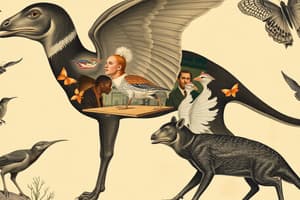Podcast
Questions and Answers
What is the main characteristic of organisms classified under Eukarya?
What is the main characteristic of organisms classified under Eukarya?
- Decompose dead material
- Help recycle nutrients in ecosystems
- Single-celled organisms
- Cells with nuclei (correct)
Which taxonomic domain includes animals within the animal kingdom?
Which taxonomic domain includes animals within the animal kingdom?
- Protists
- Eukarya (correct)
- Archaea
- Bacteria
What is the main characteristic of fungi within the classification of animals?
What is the main characteristic of fungi within the classification of animals?
- Decompose dead material (correct)
- Cells with nuclei
- Help recycle nutrients in ecosystems
- Single-celled organisms
What is the primary function of taxonomy when it comes to animals?
What is the primary function of taxonomy when it comes to animals?
Which superkingdom includes animals within the Eukarya domain?
Which superkingdom includes animals within the Eukarya domain?
What is the primary focus of behavioral biology?
What is the primary focus of behavioral biology?
Which animals have been selectively bred by humans for various purposes?
Which animals have been selectively bred by humans for various purposes?
What is a common method through which animals communicate with each other?
What is a common method through which animals communicate with each other?
What do animal welfare organizations primarily aim to improve?
What do animal welfare organizations primarily aim to improve?
Why do countries have wildlife management programs in place?
Why do countries have wildlife management programs in place?
Flashcards are hidden until you start studying
Study Notes
Animals have been part of human life since ancient times, with numerous species playing various roles in our ecosystems, economies, and societies. They range from tiny insects and microorganisms to large mammals such as elephants and giraffes. In this article, we will explore some fascinating aspects of animals, covering their classification, behavior, relationships with humans, and more.
Classification of Animals
Animals can be classified into several major groups based on shared characteristics. These include:
- Eukarya - Organisms containing cells with nuclei, which includes all animals.
- Protists - A diverse group that includes amoebas, paramecia, and slime molds; these single-celled organisms often exhibit characteristics of both plants and animals.
- Fungi - Single-celled or multicellular organisms that decompose dead material and help recycle nutrients in ecosystems.
Within the animal kingdom, there are three main taxonomic domains: Bacteria, Archaea, and Eukarya, with Eukarya being further divided into two superkingdoms: Opisthokonta (which includes animals) and Amoaebozoa. Taxonomy is crucial because it enables scientists to classify animals accurately for identification purposes.
Animal Behavior and Communication
Animals display a wide variety of behaviors, including social interactions, communication methods, predator avoidance strategies, and hunting techniques. For example, some birds perform elaborate courtship dances to attract mates, while others, like rats, create complex underground tunnels to live in. Many animals also communicate with each other using vocalizations, scent signals, or body movements.
Behavioral biology, the study of how animals behave and why they do so, has uncovered many fascinating aspects of animal lives. This field has shown that animals possess cognitive abilities similar to those found in humans, such as learning, problem-solving, and memory.
Relationships between Humans and Animals
Humans and animals have had a long history of interaction, ranging from domesticating certain species to using them for food, labor, and companionship. Some examples include:
-
Domesticated Animals: Horses, dogs, cats, cows, sheep, chickens, pigs, goats, and donkeys have been selectively bred by humans for thousands of years for various purposes, such as transportation, protection, agriculture, and companionship.
-
Wildlife Management: Many countries have programs in place to manage wildlife populations to prevent overpopulation and ecological imbalances. For instance, the National Wildlife Federation works to conserve native habitats, protect threatened species, and promote lasting solutions to conservation challenges.
-
Animal Welfare: There's an ongoing debate around whether animals have rights and should be treated ethically. Animal welfare organizations work to improve the living conditions and treatment of captive wild animals and farm animals.
Conclusion
Fascinatingly complex, animals form a significant part of the world we live in. From the microscopic organisms that break down waste and pollutants to the majestic elephants and whales that roam the earth and seas, they contribute to the intricate balance of nature. Their behavior, classifications, and relationship with humans are constantly evolving fields of study, offering endless opportunities for researchers and enthusiasts alike.
Studying That Suits You
Use AI to generate personalized quizzes and flashcards to suit your learning preferences.




